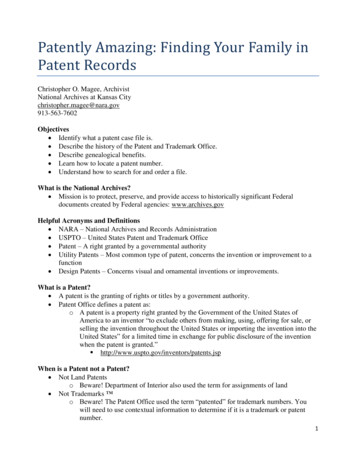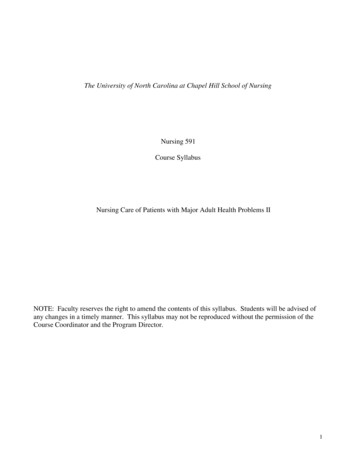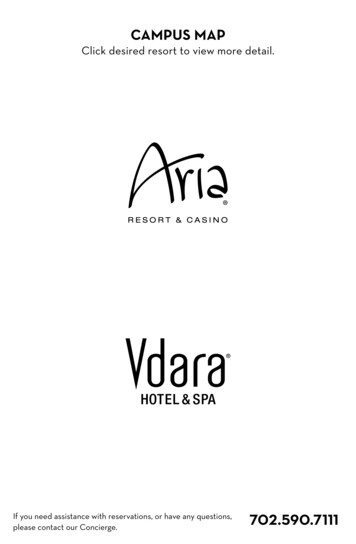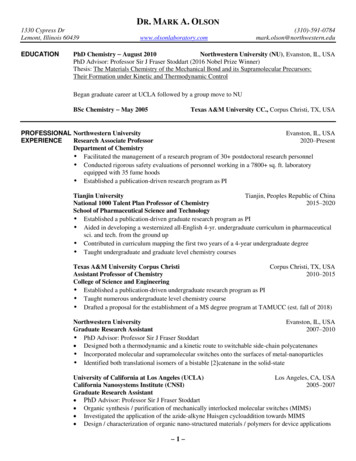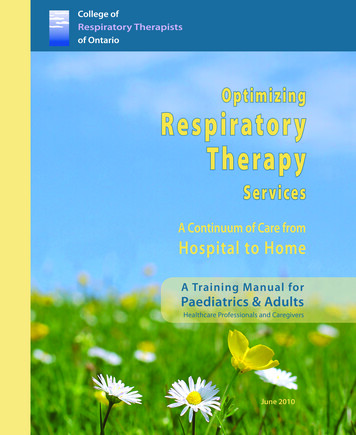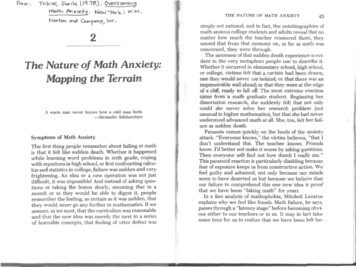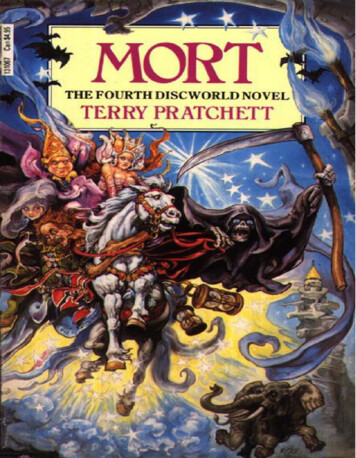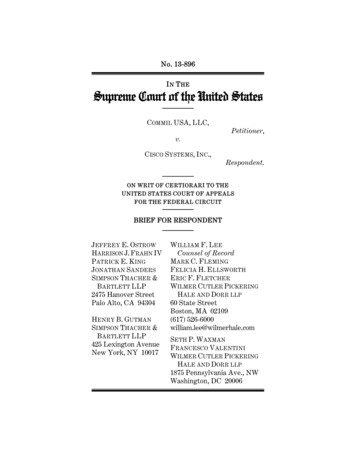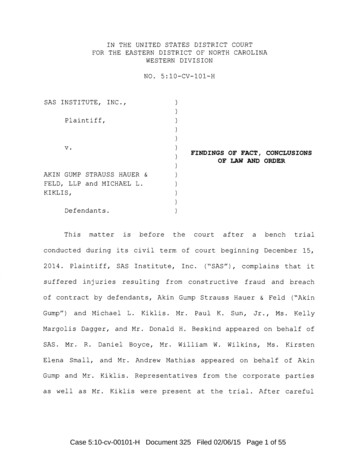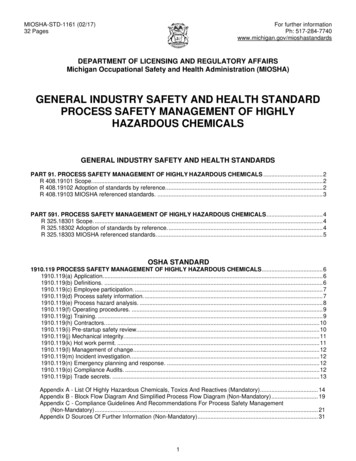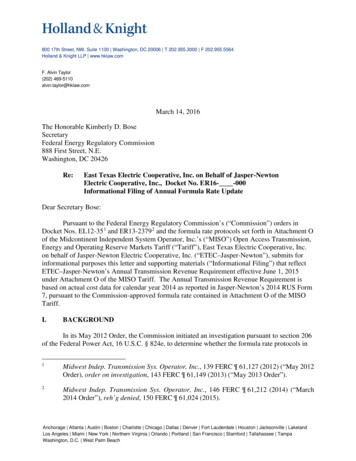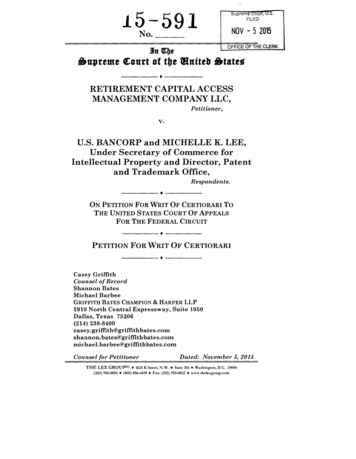
Transcription
Su6 boG , u.s.FILED15-591No.NOV - 5 2015OFFICE OF THE CLERK nSupreme Ceu t ef the Unitel StateeRETIREMENT CAPITAL ACCESSMANAGEMENT COMPANY LLC,Petitioner,U.S. BANCORP and MICHELLE K. LEE,Under Secretary of Commerce forIntellectual Property and Director, Patentand Trademark Office,Respondents.ON PETITION FOR WRIT OF CERTIORARI TOTHE UNITED STATES COURT OF APPEALSFOR THE FEDERAL CIRCUITPETITION FOR WRIT OF CERTIORARICasey GriffithCounsel of RecordShannon BatesMichael BarbeeGRIFFITH BATES CHAMPION HARPER LLP5910 North Central Expressway, Suite 1050Dallas, Texas 75206(214) comCounsel for PetitionerDated: November 5, 2015THE LEX GROUPpc 1825 K Street, N.W. Suite 103 Washington, D.C. 20006(202) 955-0001 (800) 856-4419 Fax: (202) 955-0022 w ’w.thelexgroup.com
BLANK PAGE
QUESTIONS PRESENTEDIn 2011, Congress enacted the Leahy-SmithAmerica Invents Act (hereinafter "AIA" or "the Act"),Pub. L. No. 112-29, 125 Stat. 284 (2011). The Actcreated three new post-grant administrativeproceedings for challenging the validity of patents.It also created within the Patent and TrademarkOffice ("PTO") a new tribunal called the Patent Trialand Appeal Board (hereinafter the "Board") topreside over these new proceedings. One of thenewly created proceedings is the transitional postgrant review, also known as "covered businessmethod" or "CBM" review, for patents directed to afinancial product or service. The AIA limits theBoard’s jurisdiction with respect to CBM review tochallenges based on any ground that could be raisedunder paragraph (2) or (3) of 35 U.S.C. § 282(b).Paragraph 2 provides that a party may seek toinvalidate a patent or claim on any ground specifiedin part II of Title 35 as a condition for patentability.The questions presented arise from theFederal Circuit affirming, without comment, theBoard’s holding that 35 U.S.C. § 101 is a groundspecified in part II of Title 35 as a condition forpatentability and therefore constitutes a properbasis for review in a CBM proceeding, and from theFederal Circuit affirming the Board’s application of§ 101 to the patent claims at issue. They are:1. Whether subject matter eligibility under 35U.S.C. § 101 is a ground specified as a condition forpatentability under 35 U.S.C. § 282(b)(2).
ii2. Whether the Board errs when it invalidatesissued patent claims posing no risk of pre-emptionunder the abstract idea exception to patenteligibility.
iiiPARTIES TO THE PROCEEDINGSPetitioner is Retirement Capital AccessManagement Company, LLC ("RCAMC") andRespondents are U.S. Bancorp and Michelle K. Lee,Under Secretary of Commerce for IntellectualProperty and Director, Patent and TrademarkOffice, who intervened in the Federal Circuit todefend the decision of the Board.
ivCORPORATE DISCLOSURE STATEMENTRCAMC has no parent corporation, and nopublicly held company owns 10 percent or more of itsstock.
VTABLE OF CONTENTSPageQUESTIONS PRESENTED .iPARTIES TO THE PROCEEDINGS .iiiCORPORATE DISCLOSURE STATEMENT .ivTABLE OF CONTENTS .vTABLE OF AUTHORITIES .xiOPINIONS BELOW . 1JURISDICTION . 1ANDSTATUTORYREGULATORYPROVISIONS INVOLVED .1STATEMENT OF THE CASE .2A.Covered Business Method PatentReview .2B.Proceedings Below .3ARGUMENT ENTS UNDER § 101 . 6
vinoBoCoD EoChallenges to the validityof a patent in a CBMproceeding are statutorilylimitedtogrounds"specified" in the PatentAct "as a condition forpatentability". .7The plain text andstructure of the Patent Actsupports the conclusionthat § 101 is not specifiedas a condition forpatentability .8Because the relevantlanguage of the Patent Actis unambiguous, thelegislative history is11immaterial .Neither opinion cited bythe Board as precedentaddressed whether § 101 isaconditionforpatentability . 12TheFederal Circuit’srecent decision in Versataisbasedonamisinterpretation ofthePatent Act and does notjustify permittingtheBoard to exceeditsstatutory authority .17
viiFoII.The decisions belowpresent an undecided issueof exceptional importanceto the patent system andeconomy .18PATENT CLAIMS POSING NORISK OF PRE-EMPTION DONOT FALL WITHIN THEABSTRACT IDEA EXCLUSIONTO PATENT ELIGIBILITY .19Pre-emptionisthetouchstone of the abstractidea exception to subjectmatter eligibility, and the’582 patent claims pose norisk of pre-emption .21BoThere is no recordevidence to support U.S.Bancorp’s contention thatthe challenged claims ofthe ’582 patent are invalidineligibleas patentabstract ideas .22CoThe Board erred by failingto consider whether thepractical, non-infringingalternatives to the allegedabstract idea confirmedthe ’582 patent claims poseno risk of pre-emption here .26
oo.VlllDoThe Board erred by failingto consider whether the’582 patent means-plusfunction machine claimspose a risk of pre-emptionhere .27The ’582 patent poses norisk of pre-emption anddoes not fall within thenarrow scope of theabstract idea exclusion topatent eligibility .28III.THIS CASE IS AN IDEALVEHICLETOCORRECTMISAPPLICATION OF THE AIAIN CBM REVIEWS .29APPENDIX:Judgment ofThe United States Court of Appeals forThe Federal Circuitentered August 7, 2015 .laFinal Written Decision ofThe United States Patent andTrademark OfficeBefore the Patent Trial and Appeal Boardentered August 22, 2014 .10a
ixDecision ofThe United States Patent andTrademark OfficeBefore the Patent Trial and Appeal BoardRe: Granting Reviewentered September 20, 2013 .35a15 U.S.C. § 7St(e) . 55a28 U.S.C. § 1295(a)(4)(A) . 55a35 U.S.C. § 100(b) . 56a35 U.S.C. § 101 . 56a35 U.S.C. § 102 . 57a35 U.S.C. § 103 . 59a35 U.S.C. § 112 . 62a35 U.S.C. § 141(c) . 63a35 U.S.C. § 251 . 63a35 U.S.C. § 282 . 64a35 U.S.C. § 311(b) . 67a35 U.S.C. § 321(b) . 67a35 U.S.C. § 322 . 67a35 U.S.C. § 326(e) . 69a
X35 U.S.C. § 329 . 69a§ 18 of the America Invents Act .69aUS Patent No. 6,625,582 B2 . 75aPatent Owner Retirement Capital AccessManagement Company LLC’s Responseentered November 20, 2013 .119aCorrected Petition for Covered BusinessMethod Patent Review Under 35 U.S.C. § 321and 37 C.F.R. § 42.300 et seq.entered April 3, 2013 . 168aAIA FAQ (last accessed Nov. 3, 2015 at11:47 a.m. CST) .213a
xiTABLE OF AUTHORITIESPage(s)CASESAlice Corp. Pty. Ltd. v. CLS Bank Int’l,134 S. Ct. 2347 (2014) .passimAm. Tobacco Co. v. Patterson,456 U.S. 63 (1982) . 11Ardestani v. INS,502 U.S. 129 (1991) . 11Aristocrat Techs. Austl. PTY Ltd. v.Int’l Game Tech.,543 F.3d 657 (Fed. Cir. 2008) . 12, 15Baltimore & Ohio R.R. Co. v.Aberdeen & Rockfish R.R. Co.,393 U.S. 87 (1968) . 29Barnhart v. Sigmon Coal Co.,534 U.S. 438 (2002) . 6, 8, 12Bilski v. Kappos,561 U.S. 593 (2010) .passimBrand v. Miller,487 F.3d 862 (Fed. Cir. 2007) .29Brecht v. Abrahamson,507 U.S. 619 (1993) . 16
xiiChickasaw Nation v. United States,534 U.S. 84 (2001) .12CLS Bank Int’l v. Alice Corp. Pty. Ltd.,717 F.3d 1269 (Fed. Cir. 2013) . 20, 21Cohens v. Virginia,19 U.S. 264 (1821) .16Conn. Nat’l Bank v. Germain,503 U.S. 249 (1992) .8Consol. Fruit-Jar Co. v. Wright,94 U.S. 92 (1876) .18CyberSource Corp. v. Retail Decisions, Inc.,654 F.3d 1366 (Fed. Cir. 2011) .17Diamond v. Diehr,450 U.S. 175 (1982) . 13, 15, 16, 19Gottschalk v. Benson,409 U.S. 63 (1972) .20Graham v. John Deere Co. of Kansas City,383 U.S. 1 (1966) . 12, 13, 15, 16Hartford Underwriters Ins. Co. v.Union Planters Bank, NA,530 U.S. 1 (2000) .8Helios Software, LLC v. SpectorSoft Corp.,No. CV 12-081-LPS, 2014 WL 4796111(D. Del. Sept. 18, 2014) .23
.ooX111In re Alappat,33 F.3d 1526 (Fed. Cir. 1992) .27In re Bilski,545 F.3d 943 (Fed. Cir. 2008) .27In re Zurko,258 F.3d 1379 (Fed. Cir. 2001) .25INS v. Cardoza-Fonseca,480 U.S. 421 (1987) . 12J.E.M. Ag Supply, Inc. v.Pioneer Hi-Bred Int’l, Inc.,534 U.S. 124 (2001) . 16K/ S Himpp v. Hear-Wear Techs., LLC,751 F.3d 1362 (Fed. Cir. 2014) .25Kearns v. Gen. Motors Corp.,94 F.3d 1553 (Fed. Cir. 1996) . 18Langer v. Monarch Life Ins. Co.,966 F.2d 786 (3d Cir. 1992) .26Mayo Collaborative Servs. v.Prometheus Labs., Inc.,132 S. Ct. 1289 (2012) .passimMySpace, Inc. v. GraphOn Corp.,672 F.3d 1250 (Fed. Cir. 2012) . 9, 15PNC Bank v. Secure Axcess, LLC,No. CBM2014-00100, 2014 WL 4537440(P.T.A.B. September 9, 2014) .24
xivRisetto v. Plumbers and Steamfitters Local 343,94 F.3d 597 (9th Cir. 1996) .27Robinson v. Shell Oil Co.,519 U.S. 337 (1997) . 6, 7Salinas v. U.S.,522 U.S. 52 (1997) .11State St. Bank & Trust Co. v.Signature Fin. Grp., Inc.,149 F.3d 1368 (Fed. Cir. 1998) .27United States ex rel. Turner v. Williams,194 U.S. 279 (1904) .16Util. Air Regulatory Grp. v. EPA,134 S. Ct. 2427 (2014) . 10, 19Versata Dev. Group, Inc. v. SAP Am., Inc.,793 F.3d 1306 (Fed. Cir. 2015) . 17, 18Wright v. United States,302 U.S. 583 (1938) .16STATUTES28 U.S.C. § 1254(1) .128 U.S.C. § 1331 . 328 U.S.C. § 1338(a) .335 U.S.C. § 101 . passim
xv35 U.S.C. § 102 . 4, 8, 12, 1535 U.S.C. § 103 . 4, 8, 12, 1535 U.S.C. § 112 . 2, 7, 12, 2735 U.S.C. § 251 . 2, 735 U.S.C. § 251(d) . 1235 U.S.C. § 282(b)(2) .passim35 U.S.C. § 282(b)(3) . 2, 7, 1035 U.S.C. § 321(b) . 2, 7, 935 U.S.C. § 322 . 3, 2235 UoS.C. § 326(e) . 3, 22OTHER AUTHORITIES157 Cong. Rec. H4505 (June 23, 2011) .18157 Cong. Rec. S1381 (March 8, 2011) .18AIA, Pub. L. No. 112-29, § 18(a)(1),125 Stat. 284 (2011) . 2, 3, 7, 22Dimitris Chorafas, INTRODUCTION TODERIVATIVE FINANCIAL INSTRUMENTS (2008) .24
xviHenry Crosby Emery, Speculation on theStock and Produce Exchanges of the UnitedStates, in 7 STUDIES IN HISTORY, ECONOMICSAND PUBLIC LAW (1896) .23-24H.R. Rep. No. 1923, 82d Cong., 2d Sess.,6 (1952) .9Patent Act, H.R. 1275, 109th Cong.§ 324 (2005) .12Stephen Ross, Randolph Westerfield, &Bradford Jordan, FUNDAMENTALS OFCORPORATE FINANCE (Sth ed. 2008) .24S. Rep. No. 82-1979 (1952) . 9-10Clyde Stickney, Roman Weil, K. Schipper, &Jennifer Francis, FINANCIAL ACCOUNTING: ANINTRODUCTION TO CONCEPTS, METHODS, ANDUSES (13th ed. 2010) .24
1PETITION FOR A WRIT OF CERTIORARIPetitioner RCAMC respectfully petitions for awrit of certiorari to review the judgment of theUnited States Court of Appeals for the FederalCircuit in this case.OPINIONS BELOWThe opinion of the Federal Circuit, App. at la9a, is reported at 611 Fed. App’x 1007 (Mere.). Thefinal written decision of the Board, App. at 10a-34a,is not reported but can be found at 2014 WL4229953. The decision of the Board to institutecovered business method patent review, App. at 35a54a, is not reported but can be found at 2013 WL8538864.JURISDICTIONThe Federal Circuit entered its judgment onAugust 7, 2015. App. at la-9a. The jurisdiction ofthis Court is invoked under 28 U.S.C. § 1254(1).STATUTORY AND REGULATORYPROVISIONS INVOLVEDThe relevant statutory and regulatoryprovisions are reproduced in the appendix to thispetition. App. at 55a-74a.
2STATEMENT OF THE CASEA.Covered Business Method PatentReviewIn 2011, Congress enacted the AIA, creating,among other things, the CBM review for challengingthe validity of financial product and service patents.To hear these challenges, as well as others, Congressformed the Board within the PTO. The Board’sjurisdiction with respect to CBM review is limited tochallenges based on any ground that could be raisedunder paragraph (2) or paragraph (3) of 35 U.S.C.§ 282(b). 35 U.S.C. § 321(b); see also AIA, Pub. L.No. 112-29, § 18(a)(1), 125 Stat. 284, 331 (2011).Paragraph 2 provides that a party may seekinvalidity of a patent or any claim "on any groundspecified in part II [of Title 35] as a condition forpatentability." 35 U.S.C. § 282(b)(2). Paragraph 3provides that a party may seek invalidity of a patentor any claim for failure to comply with: (a) anyrequirement of § 112 (excluding failure to disclosebest mode); or (b) any requirement of § 251. Id.§ 282(b)(3).Under the CBM review system, to initiate achallenge to the validity of an existing patent, thepetitioner must identify in writing and withparticularity:the evidence that supports the groundsfor the challenge to each claim,including--(A) copies of patents andprinted publications that the Appelleerelies upon in support of the petition;
3and (B) affidavits or declarations ofsupporting evidence and opinions, if theAppellee relies on other factualevidence or on expert opinions .AIA § 18(a)(1); 35 U.S.C. § 322. The petitioner alsohas the burden of proving a proposition of invalidityby a preponderance of the evidence. AIA § 18(a)(1);35 U.S.C. § 326(e).B.Proceedings BelowRCAMC is the owner of U.S. Patent No.6,625,582 ("the ’582 patent"). In June 2012,RCAMC, which is owned by the inventors of the ’582patent, and its exclusive licensee, Benefit FundingSystems LLC, sued U.S. Bancorp for infringement ofthe ’582 patent in the District Court for the Districtof Delaware in Benefit Funding Sys. LLC v. U.S.Bancorp, No l:12-cv-803-LPS (D. Del. filed June 22,2012).1 Jurisdiction was invoked under 28 U.S.C.§§ 1331 and 1338(a).In March 2013, U.S. Bancorp filed a petitionrequesting post-grant review of the ’582 patentunder the transitional program for CBM patents. Itsought CBM review on the sole basis that claims 1,13, 14, 18, 30, and 31 are directed to unpatentablesubject matter under § 101. RCAMC subsequentlyfiled a Preliminary Response.1 Unless otherwise stated, the procedural history recited hereinis taken from the Background section of the Final WrittenDecision of Board. App. at 10a-12a.
4In September 2013, the Board instituted CBMreview. After reviewing the challenged claims, theBoard ultimately determined U.S. Bancorpsufficiently demonstrated it was more likely than notthe challenged claims were unpatentable, grantedU.S. Bancorp’s petition, and instituted a trial.In November 2013, RCAMC filed a Responsearguing that § 101 is not a proper ground for reviewin CBM proceedings and the challenged claims of the’582 patent are patentable. On January 21, 2014,U.S. Bancorp filed its Reply. Both parties requestedan oral hearing, and the oral hearing was held inApril 2014.On August 22, 2014, the Board issued a finalwritten decision. App. at 10a-34a. The Boarddisagreed with RCAMC’s position that thedetermination of patent eligibility under § 101 is nota condition for patentability, such as those set forthin 35 U.S.C. §§ 102 and 103. App. at 19a. In doingso, it referred to case law, stating that both theSupreme Court and the Federal Circuit recognize§ 101 as a condition for patentability. App. at 19a20a. The Board also took the position the legislativehistory of the AIA indicates Congress intended theBoard to consider challenges brought under § 101 forpost-grant reviews. App. at 20a. It ultimatelyconcluded § 101 is a proper ground upon which aCBM review can be maintained. App. at 21a.The Board then applied a patentabilityanalysis under § 101. App. 21a-33a. It made no preemption determination and stated: "pre-emption isonly one test used to determine whether a claim is
5directed to an abstract idea." App. at 32a. TheBoard opined that the identified abstract concept "isan economic practice long prevalent in our system ofcommerce and squarely within the realm of abstractideas." App. at 24a. It cited no record evidence insupport of this position. See id. It then concludedthe challenged claims of the ’582 patent areunpatentable under § 101. App. at 33a.RCAMC appealed to the Federal Circuit, andthe PTO intervened to defend the Board’s decision.On August 7, 2015, after briefing and oral argument,the Federal Circuit issued a Notice of Entry ofJudgment Without Opinion, thereby affirming theBoard’s decision in its entirety without comment.App. at la-9a.ARGUMENTThe AIA does not provide the Boardjurisdiction to conduct CBM reviews on the basis of35 U.S.C. § 101, yet it is regularly doing so in excessof its jurisdictional authority. By ignoring the plainlanguage of the jurisdictional statute--a practicenow approved by the Federal Circuit--the Board hasfundamentally altered the newly enacted statutoryscheme. The Court’s intervention is needed to haltthe Board’s consistent invalidation of issued patentson unauthorized grounds, and this case is the propervehicle to do so.In the proceedings below, the Board institutedCBM review of the ’582 patent solely under § 101.Against the argument of Petitioner RCAMC, it thenexpressly held that § 101 is a valid ground for CBM
6review. The Federal Circuit approved of thispractice (and implicitly the review itself) byaffirming, without comment, the Board’s holding.Making matters worse, the Federal Circuit alsoaffirmed the Board’s position that the risk of preemption is only one test used to determine whetherpatent claims meet the abstract idea exception topatentability. This holding is in clear contraventionof the § 101 jurisprudence of this Court--namely,that risk of preemption is the foundational thresholdissue used to determine whether patent claimsembody a patent-ineligible abstract idea.There is no dispute over the centrality of theseissues to the proper functioning of the AIA, andindeed to the patent system as a whole. Absentcorrection by this Court, the Board will continue toexceed its authority by invalidating patents under§101.THE BOARD LACKS JURISDICTION TOINVALIDATE ISSUED PATENTS UNDER§101.Statutory construction begins with thelanguage of the statute. Barnhart v. Sigmon CoalCo., 534 U.S. 438, 450 (2002). From the outset, acourt must determine whether the language at issuehas a plain and unambiguous meaning in the contextof the particular dispute. Robinson v. Shell Oil Co.,519 U.S. 337, 340 (1997). If the statutory languageis unambiguous, there is no step two--the inquirymust cease. Id. To determine if the language of astatute is ambiguous, courts look to the relevantlanguage itself, the specific context in which it is
used, and the broader context of the statute as awhole. Id. at 341. Applying these factors heredemonstrates the relevant provisions of the PatentAct plainly and unambiguously exclude § 101 fromthe scope of CBM review.Challenges to the validity of apatent in a CBM proceeding arestatutorily limited to grounds"specified" in the Patent Act "as acondition for patentability."A petitioner in a transitional proceeding "mayrequest to cancel as unpatentable one or more claimsof a patent on any ground that could be raised underparagraph (2) or (3) of [35 U.S.C.] 282(b)." 35 U.S.C.§ 321(b); see also AIA, Pub. L. No. 112-29, § 18(a)(1),125 Stat. 284, 331 (2011). Under paragraph (2) of§ 282(b), a party may seek invalidity of a patent orany claim "on any ground specified in part H [of Title35] as a condition for patentability." 35 U.S.C.§ 282(b)(2) (emphasis added). Paragraph (3) of§ 282(b) provides that a party may seek invalidity ofa patent or any claim for failure to comply with: (a)any requirement of § 112 (excluding failure todisclose best mode); or (b) any requirement of § 251.Id. § 282(b)(3). Hence, § 101 can constitute a basisfor instituting a CBM review only if it is a ground"specified" in part II of Title 35 "as a condition forpatentability".
8The plain text and structure of thePatent Act supports the conclusionthat § 101 is not specified as acondition for patentability.When a statute’s language is plain, the solefunction of the courts--at least where the dispositionrequired by the text is not absurd is to enforce thestatute according to its terms. HartfordUnderwriters Ins. Co. v. Union Planters Bank, NA,530 U.S. 1, 5 (2000). Indeed, courts "must presumethat a legislature says in a statute what it meansand means in a statute what it says." Barnhart v.Sigmon Coal Co., 534 U.S. 438, 461-62 (2002)(internal quotations and citations omitted). "Whenthe words of a statute are unambiguous, then, thisfirst canon is also the last: judicial inquiry iscomplete." Barnhart, 534 U.S. at 462 (quoting Conn.Nat’l Bank v. Germain, 503 U.S. 249, 253-54 (1992)).The plain language of the relevant provisions of thePatent Act excludes § 101 from the scope of CBMreview.Part II of Title 35 encompasses sections 100212. Of numerous sections in Part II, only two arespecified as a "condition for patentability." Section102 is titled "Conditions for patentability; novelty"and § 103 is titled "Conditions for patentability; nonobvious subject matter." Moreover, no other sectioncontained in Part II includes the terms "condition"and "patentability" anywhere, either in the title or inthe body. Thus "[t]he two sections of part II thatCongress has denominated as ’conditions ofpatentability’ are § 102 (’novelty and loss of right topatent’) and § 103 (’nonobvious subject matter’)."
9MySpace, Inc. v. GraphOn Corp., 672 F.3d 1250,1260 (Fed. Cir. 2012). Even if statutory headingsare generally not dispositive, the circumstances aredifferent here--the term "specified" focuses onprecise identification, i.e., labels. This point isbolstered by the fact Congress textually designated§§ 102 and 103 in Part II as "conditions forpatentability." Section 101 is not specified as acondition for patentability; it falls outside § 321(b)and cannot form the basis of CBM review.The text of § 101 reinforces that the languageof § 282(b)(2) is unambiguous. Section 101 states:"[w]hoever invents or discovers any new and usefulprocess . . or any new and useful improvementthereof, may obtain a patent therefore," but doing sois "subject to the conditions and requirements of thistitle." 35 U.S.C. § 101 (emphasis added). Somethingcannot be a condition of the title when it is subject tothe conditions of the title. Something cannot be"subject to" its own existence. Again, nowherewithin part II is § 101 "specified" as a condition forpatentability--not in the label or text. But besidethat significant point, § 101 does not contain"conditions" for patentability; rather, it sets forth thesubject matter that can be patented, hence the title"inventions patentable." See Mayo CollaborativeServs. v. Prometheus Labs., Inc., 132 S. Ct. 1289,1303-04 (2012) (quoting H.R. Rep. No. 1923, 82dCong., 2d Sess., 6 (1952) ("A person may have’invented’ a machine or a manufacture, which mayinclude anything under the sun that is made byman, but it is not necessarily patentable undersection 101 unless the conditions of the title arefulfilled") (emphasis added)); S. Rep. No. 82-1979, at
102399 (1952) ("Section 101 sets forth the subjectmatter that can be patented, ’subject to theconditions and requirements of this title.’ Theconditions under which a patent may be obtainedfollow, and section 102 covers the conditions relatingto novelty. A person may have ’invented’ a machineor manufacture, which may include anything underthe sun that is made by man, but it is not necessarilypatentable under section 101 unless the conditions ofthe title are fulfilled."). There lies the distinction.Alarmingly, and contrary to the Board’sposition below, even the guidance provided by thePTO’s own website excludes § 101 as a ground uponwhich a petitioner may challenge a patent in a CBMreview. The PTO’s "FAQ" states: "A petitioner forpost grant review may request to cancel asunpatentable one or more claims of a patent on anyground that could be raised under paragraph (2) or(3) of 35 U.S.C. 282(b) relating to invalidity (i.e.,novelty, obviousness, written description,enablement, indefiniteness, but not best mode)."App. at 213a. In sum, the plain language of§ 282(b)(2) unambiguously excludes § 101 as a basisfor CBM review, and transitional CBM reviewproceedings may not be instituted on the basis of§ 101. See Util. Air Regulatory Grp. v. EPA, 134 S.Ct. 2427, 2446 (2014) ("We reaffirm the coreadministrative-law principle that an agency may notrewrite clear statutory terms to suit its own sense ofhow the statute should operate.").
11Because the relevant language ofthe Patent Act is unambiguous, thelegislative history is immaterial."The strong presumption that the plainlanguage of the statute expresses congressionalintent is rebutted only in rare and exceptionalcircumstances, when a contrary legislative intent isclearly expressed." Ardestani v. INS, 502 U.S. 129,135-36 (1991) (internal citations and quotationsomitted); see also Salinas v. U.S., 522 U.S. 52, 57(1997) (internal citations and quotations omitted)("Only the most extraordinary showing of contraryintentions in the legislative history will justify adeparture from the language"); Am. Tobacco Co. v.Patterson, 456 U.S. 63, 68 (1982) ("absent a clearlyexpressed legislative intention to the contrary,[statutory] language must ordinarily be regarded asconclusive"). Because the statutory languagediscussed above is unambiguous, the legislativehistory of the AIA is immaterial. It is also notrelevant to the meaning of "specified in part II as acondition for patentability" given the terms"specified" and "condition for patentability" in 35U.S.C. § 282(b)(2) were first enacted in the 1952Patent Act--not the AIA.Earlier versions of what eventually becameenacted in the AIA conclusively show Congress knewhow to provide that § 101 would be a basis for CBMreview. One piece of predecessor legislationprovided, "The issues of invalidity that may beconsidered during the [post grant] oppositionproceeding are double patenting and any of therequirements of patentability set forth in sections
12101, 102, 103, 112, and 251(d)." Patent Act, H.R.1275, 109th Cong. § 324 (2005). This Court"ordinarily will not assume that Congress intended’to enact statutory language that it has earlierdiscarded in favor of other language."’ ChickasawNation v. United States, 534 U.S. 84, 93 (2001)(quoting INS v. Cardoza-Fonseca, 480 U.S. 421, 443(1987)). Yet, that is what the Board contends theCourt should do. Because courts "must presumethat a legislature says in a statute what it meansand means in a statute what it says," Barnhart, 534U.S. at 461-62, the AIA should not be construed incontravention of the plain language excluding § 101as a basis for CBM review.DoNeither opinion cited by the Boardas precedent addressed whether§ 101 is a condition forpatentability.The only "precedent" cited by the Board isGraham v. John Deere Co. of Kansas City, 383 U.S.1, 12 (1966), and Aristocrat Techs. Austl. PTY Ltd. v.Int’l Game Tech., 543 F.3d 657, 661 (Fed. Cir. 2008),neither o
15-591 No. n Su6 boG , u.s. FILED NOV - 5 2015 OFFICE OF THE CLERK Supreme Ceu t ef the Unitel Statee RETIREMENT CAPITAL ACCESS MANAGEMENT COMPANY LLC,
